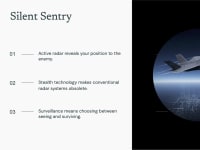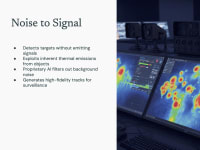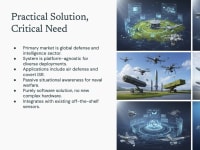What problem does your design idea solve?
On the modern battlefield, a critical dilemma exists: to see, one must emit energy with active radar, which instantly reveals one's position to be jammed or targeted. This makes surveillance a high-stakes gamble. Furthermore, the proliferation of stealth technology has rendered many conventional radar systems obsolete, creating a dangerous gap in national defense. Our design solves the challenge of detecting advanced threats without becoming one.
How does your design work?
Our solution is a software system that transforms existing passive microwave sensors into advanced threat detectors. The system is based on Passive Microwave Radiometry (PMR), which "listens" for the faint, naturally emitted thermal radiation from all objects. The core of our technology is a proprietary neural network that processes this data. It intelligently filters out complex background noise to isolate the unique thermal signatures of targets, turning a noisy environment into a clear, actionable intelligence picture that works day or night, in any weather.
How is your idea novel and what are the potential benefits?
This system represents a significant advance over the state-of-the-art. Its novelty lies in the software-driven ability to overcome the traditional limitations of passive sensing, delivering two game-changing benefits:
Benefit 1: It Detects the "Invisible." Our neural network can identify the minute thermal contrast between a stealth aircraft and the cold background of the sky. This allows it to detect low-observable threats that are explicitly designed to be invisible to the active radar systems that form the backbone of modern air defense, improving public safety and security.
Benefit 2: It Ensures Survivability. As a completely passive, non-emitting system, it has a Low Probability of Intercept (LPI). Users can monitor adversaries continuously without ever revealing their own location, saving the lives of military personnel by preventing them from being targeted. This silent vigilance also saves time and money by providing persistent surveillance without the risks associated with active sensor platforms.
Where would this idea be applied and what is the market potential?
The primary market is the global defense and intelligence community, with direct applications in air defense, naval warfare, and ground-based reconnaissance. The growing investment in counter-stealth capabilities and survivable ISR (Intelligence, Surveillance, and Reconnaissance) assets represents a multi-billion dollar market. Any platform—from ships and aircraft to vehicles and fixed sites—can be retrofitted, creating a vast and immediate addressable market and bolstering the economy by creating high-tech software and integration jobs.
How would your product be manufactured and how would its cost compare?
This is a purely software solution, making it exceptionally feasible and cost-effective. Production involves software development and deployment, eliminating the need for new hardware manufacturing lines. It is designed to be installed on a wide range of existing, military-grade sensors. Compared to the immense cost of developing, producing, and fielding a new hardware-based radar system, our software offers a revolutionary capability upgrade at a fraction of the price. It enables a dramatic improvement in other products (existing sensors) while reducing the consumption of natural resources associated with new hardware production.
Like this entry?
-
About the Entrant
- Name:Robert Moerck
- Type of entry:individual
- Patent status:none









